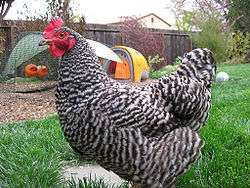Plymouth Rock chicken
 Barred Plymouth Rock hen | |
| Conservation status | Recovering |
|---|---|
| Other names |
Rock Barred Rock |
| Country of origin | United States |
| Standard | |
| Use | Dual-purpose breed |
| Traits | |
| Weight |
Male: Standard: minimum 3.4 kg (7.5 lb)[1]:241 Bantam: maximum 1.36 kg (3.0 lb)[1]:242 |
|
Female: Standard: minimum 2.95 kg (6.5 lb)[1]:241 Bantam: maximum 1.13 kg (2.5 lb)[1]:242 | |
| Skin color | Yellow |
| Egg color | Brown |
| Comb type | Single |
| Classification | |
| APA | American[2] |
| ABA | Single comb clean legged |
| EE | yes[3] |
| PCGB | Soft feather: heavy[4] |
| APS | heavy breed softfeather |
|
Chicken Gallus gallus domesticus | |

The Plymouth Rock is a breed of domestic chicken from the United States. It originated in New England in the 19th century from cross-breeding of Dominiques and Black Javas.
History
The Plymouth Rock was developed in New England in the early 1800s by crossing Dominiques and Black Javas.. John C. Bennett (1804–1867) has been credited with either creating or popularizing the breed.
Colors
In the United States, the United Kingdom and Canada, seven color varieties of the Plymouth Rock are recognized: Barred, Blue, Buff, Columbian, Partridge, Silver-penciled and White. In Australia, the Barred variant is split into two separate colors, Dark Barred and Light Barred.[5] The difference between these colors is highly noticeable, with the bars of white color wider and the grey lighter in the Light Barred than in Dark Barred.
Use
The Plymouth Rock was bred as a dual-purpose fowl, meaning that it was valued both for its meat and the egg-laying ability of the hens. It is a cold-hardy bird. The hens lay brown eggs, and continue laying all through the winter with decreased production.
See also
| Wikimedia Commons has media related to Barred Plymouth Rock. |
References
- 1 2 3 4 Victoria Roberts (2008). British poultry standards: complete specifications and judging points of all standardized breeds and varieties of poultry as compiled by the specialist breed clubs and recognised by the Poultry Club of Great Britain. Oxford: Blackwell. ISBN 9781405156424.
- ↑ APA Recognized Breeds and Varieties As of January 1, 2012. American Poultry Association. Accessed September 2015.
- ↑ Liste des races et variétés homologuée dans les pays EE (28.04.2013). Entente Européenne d’Aviculture et de Cuniculture. Accessed September 2015.
- ↑ Breed Classification. Poultry Club of Great Britain. Accessed August 2014.
- ↑ James Bishop (1998). Australian Poultry Standard, first edition. Linton, Victoria: Victorian Poultry Fanciers' Association. ISBN 9780646362311.